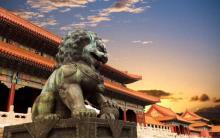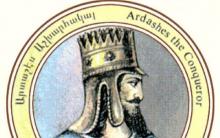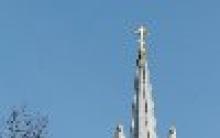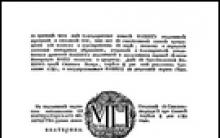What is more interesting to you - Byzantine frescoes, Italian mannerism or German expressionism? The lecture cycle includes three courses - “Culture and Art Ancient world. The Art of the Medieval East”, “The Art of Byzantium. Western European art XI-XVII centuries" and "Foreign art of the XVII-XX centuries". Classes are taught by Hermitage staff.

Those who are partial to the history, culture and traditions of the East are offered lectures by specialists from various departments of the Hermitage. There are four cycles to choose from, each of which can be considered a full-fledged academic course: “Ancient Egypt”, “India”, “China” and “Buried Kingdoms of China”.

At the lectures in this series you can learn about French artistic revolution and British watercolors, the traditions of the German early printed book and the golden age European painting, jewelry and sculpture of the 20th–21st centuries.

If you are fascinated by the civilization that gave the world the first scientific knowledge, fundamentals of mathematics, democracy, theater, classical architecture and much more, pay attention to the series dedicated to the history and culture of the Ancient World. Among the courses is “Greece. An era of great change. V-IV centuries BC”, “For the rest of the Caesars”: the imperial villas of Italy” and “Riddles of the Scythians”.

Passionate orientalists talk about the art of the Islamic world, the peculiarities of the Muslim artistic language from India to Spain, the Khorezmian settlements lost in the deserts and the mysterious empire of Khara-Khoto.

As part of this series, you can learn about the European builders of Muscovite Rus', the history of the Imperial porcelain factory, the influence of the Napoleonic wars on Russia, the construction of the New Hermitage, the fate of the personal chambers of Nicholas II and the domestic avant-garde.

The museum also offers other courses - “Hermitage curators tell us” about works that are in storage and rarely shown to the public, “Famous Collectors” about Russian and foreign art collectors, “The Hermitage. Favorites" about individual exhibits, In Memoriam about important dates for the history of art. The Hermitage also hosts lectures on temporary exhibitions.
The art of the twentieth century, even today, is shrouded in mystery. After all, a little time has passed necessary for it detailed study. From September until the end of this year, everyone can listen to lectures on contemporary art absolutely free of charge at the Youth Educational Center.
As part of the “Lexicon” series contemporary art. Problems. Directions. Names" will discuss popular trends in the art of the twentieth century. Lecturers will tell those present which of the art directions remained in the last century, and which exist in our time. The course of lectures is divided into a couple of thematic blocks: modernism and postmodernism. Each lesson will be dedicated to a separate art movement, which will provide an opportunity to study it in as much detail as possible.
The lecture schedule is published below:
September 21, 19:00- “Dadaism, or the Search for total freedom of creativity.”
September 28, 19:00- “Abstract Expressionism, or the American Contribution to Contemporary Art.”
October 5, 19:00- “Surrealism, or Imagination is ready to regain its rights.”
October 12, 19:00- “Pop art, or From kitsch to art.”
October 19, 19:00- “Hyperrealism. Op art. Kineticism. Minimalism, or Experiments with volume, light and space."
October 26, 19:00- “Philosophy of Conceptualism: Installation.”
November 2, 19:00- “Theatricalization of space: Happening. Performance"
November 9, 19:00- “Neo-expressionism and art brut.”
November 21, 19:00- “Public art and graffiti.”
November 30, 19:00- “Experiments with photography and video art.”
December 7, 19:00- “Neo-Dada and Neo-Pop Art.”
December 14, 19:00- “New figurativeness of the art object” (Hirst, Gormley, Plensa, the Chapman brothers, Fabre).
December 21, 19:00- “Metaphysics of light and space” (Tarell, Eliasson, Anish Kapoor).
December 28, 19:00- “Art and new technologies.”
In February in Hermitage lecture hall you can listen to the cycles lecture programs, dedicated different areas history and theory of art - from the Ancient world and eastern civilizations to the Renaissance, avant-garde and modernity. Lecturers are staff and collection curators State Hermitage.
You can attend one lecture you like or purchase a subscription for any cycle you like or for a season at once. The course of author's lectures allows you to join the world of culture and art together with the best art critics, historians and archaeologists of St. Petersburg.
Schedule for February 2017
February 1, 19:00 - “Celts and Roman Gaul”
University of the History of Foreign Art. I year. Lecturer - L. S. Vorotinskaya
February 2, 19:00 - “Art of Italy of the 16th century. Mannerism"
University of the History of Foreign Art. II course. Lecturer - Z. V. Kuptsova
February 3, 19:00 - “Gericault, Delacroix”
From the series: “Masters of the First half of the 19th century centuries." Lecturer - N. E. Krollau
February 4, 12:00 - “Villas of Emperor Tiberius”
February 4, 15:30 - ““He’s back!” One Hundred Days of Napoleon - on the question of the reasons and analysis of the reaction to the event”
February 5, 12:00 - “Outlandish patterned armor.” Tortoiseshell and its use"
February 5, 15:30 - “Khorezm and neighbors in the 6th century. BC. - II century AD"
February 7, 19:00 - “Architecture of the 20th century. Search for style. Modern"
University of the History of Foreign Art. III course. Lecturer - O. G. Maho
February 8, 19:00 - “Culture and art of Achaemenid Iran”
February 9, 19:00 - “Art of the Netherlands of the 15th century.”
February 10, 19:00 - “Constable, Turner”
From the series: “Masters of the first half XIX century" Lecturer - Zh. S. Bagramova
February 11, 12:00 - “Villas of the emperors in the area of Rome (Nero, Trajan and others)”
From the series: ““For the rest of the Caesars”: the imperial villas of Italy.” Lecturer - A. M. Butyagin
February 11, 15:30 - “The Battle of Waterloo - the last parade of Napoleon’s Imperial Guard”
From the series: “Russia and Napoleonic France. Reflections after the anniversary." Lecturer - P. V. Suslov
February 12, 12:00 - ““Gifts of the Sea Elements”. Sea shells, baroque pearls and mother of pearl"
From the series: “Metamorphoses. Curiosities of nature and masterpieces of art." Lecturer - A. B. Kropina
February 12, 15:30 - “Khorezm in the III–VIII centuries. AD"
From the series: “Desert castles of Khorezm.” Lecturer - P. B. Lurie
February 14, 19:00 - “The art of France in the first half of the 20th century. Matisse and Fauvism"
University of the History of Foreign Art. III course. Lecturer - N.V. Brodskaya
February 15, 19:00 - “Art of Iran III–VII centuries.”
University of the History of Foreign Art. I year. Lecturer - A. B. Nikitin
February 16, 19:00 - “Art of the Netherlands of the 16th century.”
University of the History of Foreign Art. II course. Lecturer - M. N. Chokheli
February 17, 18:30 - “Head of a monk. Fragment wall painting. Mogaoku"
From the series: “The Hermitage. Favorites. China". Lecturer - M. V. Kozlovskaya
February 17, 19:00 - “Friedrich, Runge”
February 18, 12:00 - “1917 The Hermitage between two revolutions”
In memoriam. Lecturer - E. S. Ananyeva
February 18, 15:30 - “To the 400th anniversary of the birth of Murillo.”
In memoriam. Lecturer - S. G. Pavlova
February 19, 12:00 - “Curiosities of flora and fauna.” Coconut and ostrich egg, narwhal tooth and coral"
From the series: “Metamorphoses. Curiosities of nature and masterpieces of art." Lecturer - A. B. Kropina
February 19, 15:30 - “Masters of the 18th century. (I. Pozier, G. Eckart, J. Budde, J. Fazi, J. Duval)"
February 21, 19:00 - “The art of France in the first half of the 20th century. Picasso and Cubism"
University of the History of Foreign Art. III course. Lecturer - N.V. Brodskaya.
February 22, 19:00 - “Art Central Asia VI–VIII centuries.”
University of the History of Foreign Art. I year. Lecturer - P. B. Lurie
February 23, 19:00 - “The art of Spain in the 15th–16th centuries.”
University of the History of Foreign Art. II course. Lecturer - N. S. Zabolotskaya
February 24, 19:00 - “Menzel”
From the series: “Masters of the first half of the 19th century.” Lecturer - S. V. Murashkina
February 25, 12:00 - “Villa Adriana”
From the series: ““For the rest of the Caesars”: the imperial villas of Italy.” Lecturer - A. M. Butyagin
February 25, 14:00 - “Collection chinese art in the Hermitage"
From the series: “The Keepers of the Hermitage Tell.” Lecturer - M. L. Menshikova
February 25, 15:30 - “Russia and France in 1815–1818.”
From the series: “Russia and Napoleonic France. Reflections after the anniversary." Lecturer - P. V. Suslov
February 26, 12:00 - “To the 100th anniversary of the death of Edgar Degas”
In memoriam. Lecturer - N.V. Brodskaya
February 26, 15:30 - “Russian masters of the second half of the 19th century. (I. Khlebnikov, P. Ovchinnikov, P. Sazikov, K. Faberge)"
From the series: “Masters jewelry art" Lecturer - V. S. Petrova
February 28, 19:00 - “German art of the first half of the 20th century. Expressionism"
University of the History of Foreign Art. III course. Lecturer - S. B. Esman
ENTRANCE: from 150 rubles
Main Headquarters, State Hermitage Museum, Palace Square, 6–10
Lecture hall of the State Hermitage homaaxel wrote in August 23rd, 2017
The Hermitage lecture hall is an educational platform for everyone interested in the history of art and culture. The lecture programs were developed by specialists of the State Hermitage and are unique.
You can purchase passes for the 2017-2018 lecture season on September 14 from 17.30 to 21.00 at the General Staff Office ticket office.
Lectures are held in the General Staff building and in the Staraya Derevnya Restoration and Storage Center.
The topics of the lectures introduce the development of foreign art from ancient times to the present day. Classes are designed for three academic years and include 88 lectures. Lectures are given by employees of the State Hermitage. Lectures are held on Tuesdays, Wednesdays and Thursdays at 19.00 in the General Staff Building.
Architecture Ancient Rus' and the art of the Russian avant-garde, an echo of the Napoleonic wars and memorial structures Catherine's time, the construction of the New Hermitage and the fate of the personal chambers of the last Russian emperor are the focus of researchers of Russian culture.
The Hermitage lecture hall offers separate lecture sections: “The Keepers of the Hermitage Speak”, “Famous Collectors”, “The Hermitage. Favorites", "In Memoriam"
The lecture hall at the Staraya Derevnya RHC offers listeners a variety of lecture series, dedicated to history world art from primitive era to the present day. Listeners will be able to “walk” around Rome and “visit” London museums, “get inspired” by the work of Francisco Goya and the masters of the second half of the 19th century, “become a participant” in the Venice Biennale and learn the secrets of European trellis weaving.
Direct communication with art historians, curators, and restorers introduces listeners to fascinating world art historical research, introduces original interpretations works of art, with features of their storage, study and restoration. Look behind closed doors, to see the “invisible” work of a museum curator, researcher, interpreter, to hear first-hand what will later be reflected in silent exhibits - this is what these programs offer.
Interesting meetings - “From the history of costume”, “Behind seven seals”. Meetings with curators and researchers of books, "Reviving the past... Restoration in the Hermitage."
General Staff Building (Dvortsovaya Square, 6-8);
Winter Palace (Dvortsovaya Square, 2, entrance from the square through the Main Courtyard);
Restoration and storage center “Staraya Derevnya” (Zausadebnaya st., 37, metro station “Staraya Derevnya”);
Menshikov Palace (Universitetskaya embankment, 15);
In the Foyer of the Hermitage Theater
The Hermitage is not only big museum. The Hermitage lecture hall operates specifically to open people to the world of beauty. It has two addresses: the first lecture hall is located in one of the new storage buildings, the second - in former building The main headquarters on Palace Square. It is unlikely that you will be able to visit both halls in one day, so you should prepare for your encounter with art in advance.
Lecture hall of the Hermitage General Staff
The lecture hall has existed for many years now. It is called the hall where artists' paintings come to life. Here you can listen to several series of lectures. The themes are varied, covering the entire history of mankind in the works of artists from primitive days to the present.
Caring employees work here who are happy to tell stories about the past. Under their unhurried monologue, all the slides shown on the screen no longer seem just beautiful paintings, but windows into past centuries.
The small room with red soft chairs is very cozy; each chair is equipped with a folding table for taking notes. The large slide show screen is clearly visible from all seats. Slides allow you to examine works of art in detail from an advantageous angle. As the lecture progresses, the guide draws attention to various details.
Traditionally, after each session there is applause for the narrator.
Lecture programs at the General Staff
The staff's presentations are composed in such a way that it becomes interesting both to specialists and to first-time visitors to the museum. Academic knowledge is presented in an engaging and accessible manner.
Now this Hermitage lecture hall hosts several programs:
- University of the History of Foreign Art - 3rd course.
- Eastern classes: Ancient Egypt, India, China.
- Ancient world: Greece, Italy, Scythians.
- East: the Islamic world, Khorezm, about a forgotten empire.
- Western Europe: Venice, German book, Curiosities of nature, Literary heroes, Painting of the 17th century, French weavers, Master jewelers, Service with a green frog, English watercolor, Paris of the early twentieth century, German expressionists, Sculpture of the 20th-21st centuries, Three artists of the 21st century.
- Russia: about museum exhibits.

You can visit it on weekdays; the ticket office is open from 10.30 to 19.20. On weekends, work is reduced by two hours; at 17.30 the doors are closed to visitors. Monday is a non-working day.
Lecture hall of the Hermitage in the Old Village
The historical district of the city where the storage facility is located is called the “Old Village”. This is also the name of the nearest metro. The complex was built relatively recently - the first stage was commissioned in 2003. A new lecture hall opened its doors there.
If the Hermitage lecture hall on Palace Square looks like chamber theater, then this new one is for a large university audience. The light green chairs rise in steps and have the same folding tables as in the old lecture hall.

Evening concerts are held here. The spacious, cozy hall gathers guests on Sundays at 17.30. Under the fading colors of the day, watching the sleeping garden outside the window, visitors hear the sounds of music historical era, which is narrated by an art critic.
Lecture programs in the Old Village
Here you can listen to the following topics:
- Since ancient times.
- Masters of the 19th century.
- About Ancient Greece.
- F. Goya.
- London. Museums.
- Tapestry weaving in Europe.
- Art of the 20th-21st centuries.
The following topics have been prepared especially for schoolchildren:
- European court costume of the 15th-17th centuries.
- Stories from the life of Hermitage masterpieces.
- Traveling through the countries of the East.
- Myths and legends in the fine arts.
- Weekdays and holidays of the ancient world.
- Art is all around us.
- Secrets of palaces (2 parts).

The lecture hall welcomes visitors from 10.30 to 19.00. On weekends, the working day is 1 hour shorter. Monday, Tuesday are non-working days.
Visitor reviews
Those who begin to attend the lecture series can no longer refuse. Sorry to miss another topic. Therefore, advice from experienced visitors: buy a subscription. True, you will have to wait in a long line for him - there are many people willing. Some stood for 6 hours. But it's worth it.
The history of foreign art has been studied for three years. academic years, classes are divided into 87 lectures. It is convenient to visit them - they start at 19.00, on Tuesdays, Wednesdays and Thursdays in the General Headquarters.

Many reviews quote excerpts from lectures. It's clear that people really enjoyed it. It was unexpected to see an old man museum worker, dashingly operating a computer. The lecturers’ excellent Russian language, passion for what they loved and an excellent sense of humor did their job - the audience sat for 2 hours, fascinated by the story.
Very different people visit the Hermitage lecture hall. The reviews from this motley crowd of young and old are unanimous: they had a good time, learned a lot of interesting things and were eager to visit the museum exhibition in order to see with their own eyes what was demonstrated using slides.
Addresses of lecture halls, how to get there
Both lecture halls are easy to find even for a person unfamiliar with the city. If you plan to visit the museum, then at the same time you can visit the nearby lecture hall of the General Staff.
You can get to Nevsky Prospekt by metro. Stations "Nevsky Prospekt" and "Gostiny Dvor", exit to the Griboyedov Canal. Next, we orient ourselves along the spire of the Admiralty, to the right of which is the Winter Palace.
From the Admiralteyskaya station we first exit onto Nevsky, then approach the Admiralty. The Hermitage lecture hall, whose address is Palace Square, building 6/8, has an entrance from the square.
Lecture hall in Old village located at: Zausadbnaya street, 37 A. It is better to get there by metro to the Staraya Derevnya station.
Rules for visiting the museum
A museum is a cultural object. People don’t come here in T-shirts and shorts, frivolous and similar clothes. There is no dress code, but visitors are expected to show basic respect for the heritage of many centuries.
High thin heels can damage precious parquet floors; it is also better to leave them at home. Large items and bags will be accepted by the wardrobe. Food and drinks are prohibited on museum premises.
Here you can take photographs of the exhibits for free. It is prohibited to do this only in museum storerooms. In a lifetime, a person will not be able to view all three million exhibits of the Hermitage, so take the opportunity to learn about the most interesting ones by visiting the lecture hall.











How to properly and tasty cook pancakes with cottage cheese
Rose petal jam made by me
Buckwheat with pork ribs in a slow cooker Ribs with buckwheat in a slow cooker recipes
Chicken skewers Chicken skewers with bacon
Mushroom glade salad with honey mushrooms recipe with photos How to prepare mushroom glade salad with honey mushrooms